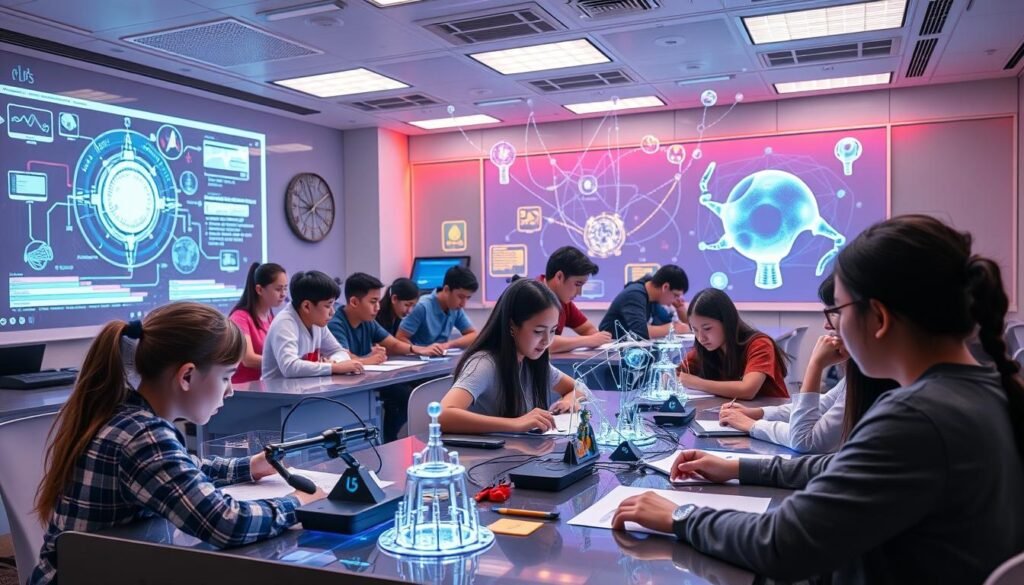The impact of artificial intelligence (AI) is huge. A study says AI could add $15.7 trillion to the global economy by 2035. As a student, you might want to learn about this tech and how it solves real problems. This guide will introduce you to AI and machine learning (ML) basics, with examples you can try.
If you’re into natural language processing, computer vision, or predictive analytics, this guide is for you. You’ll learn about AI and ML systems, including machine learning, neural networks, and deep learning. You’ll also discover Python libraries like TensorFlow and PyTorch. Plus, you’ll find hands-on projects to practice what you’ve learned.

Key Takeaways
- Gain a solid understanding of the fundamentals of artificial intelligence and machine learning
- Explore practical examples and applications of AI/ML in areas like classification, predictive analysis, and computer vision
- Learn how to build your first machine learning project using popular Python libraries and frameworks
- Discover the various types of machine learning algorithms and their use cases
- Understand the importance of data quality and quantity in the performance of machine learning models
Understanding the Foundations of AI and Machine Learning
Artificial intelligence (AI) and machine learning (ML) are often confused with each other. AI is about making systems that think like humans for tasks like solving problems. Machine learning is a part of AI that lets computers learn from data without being told how.
What is Artificial Intelligence?
Artificial intelligence (AI) is all about making smart machines. These machines can do things that humans do, like seeing, talking, and making choices. AI systems look at data, find patterns, and make smart choices based on that data.
The Role of Machine Learning in AI
Machine learning is a big part of AI. It lets computers get better at doing things over time. Machine learning uses big data to find patterns and make smart guesses or choices. This includes things like recognizing pictures and understanding language.
Key Components of AI/ML Systems
The main parts of an AI/ML system are:
- Data: The basic information, like numbers or words, that the system uses to learn.
- Algorithms: The rules or math that the system uses to understand the data and learn from it.
- Models: What the system learns from the data, used to make guesses or choices on new data.
The system learns by being trained on data, finding patterns, and then using that knowledge to guess or decide on new data.
Essential Tools and Technologies for Getting Started
To start your AI and machine learning (ML) journey, you need to know the basics. Python is the main language for AI/ML because it’s easy to use and has lots of libraries. Important Python libraries include Pandas for handling data, NumPy for math, and Matplotlib/Seaborn for showing data.
For making AI/ML models, you’ll use frameworks like TensorFlow, PyTorch, and Scikit-learn. These tools have many algorithms and features to help you build and train models. Google Colab is also great for beginners. It’s a free, cloud-based platform that gives you access to strong hardware, so you can start exploring AI/ML without setting up anything locally.
| Tool/Technology | Description |
|---|---|
| Python | The primary programming language for AI/ML, with a wide range of libraries for data manipulation, numerical operations, and visualization. |
| TensorFlow | A powerful open-source machine learning framework used for developing and deploying AI/ML models. |
| PyTorch | Another popular open-source machine learning framework known for its flexibility and ease of use. |
| Scikit-learn | A machine learning library that provides a range of algorithms for classification, regression, and clustering tasks. |
| Google Colab | A cloud-based platform that offers free access to powerful hardware, making it easier for students to get started with AI/ML. |
Learning about these essential tools and technologies will help you start your first AI/ML project. It’s a great way to explore the exciting world of AI/ML.
Artificial Intelligence and Machine Learning Examples for Students
The world is diving into artificial intelligence (AI) and machine learning (ML). Students have many chances to explore these new technologies. They can work on everything from simple tasks to complex computer vision projects. This makes learning fun and helps them understand AI and ML better.
Simple Classification Projects
Students can begin with easy projects like sorting emails or analyzing movie reviews. These tasks teach them about supervised learning. They learn to train models to sort data based on certain features.
Predictive Analysis Examples
Students can also work on predictive analysis. For example, they can predict house prices using linear regression. This shows how AI and ML are used in real life. It also helps them understand statistics better.
Computer Vision Applications
Computer vision is a fascinating field for students. They can learn by classifying images, like telling cats from dogs. This helps them understand natural language processing and robotics. It shows how AI and ML solve visual problems.
By trying out these AI and ML projects, students can see how theory meets practice. These activities improve their grasp of these technologies. They also prepare students for the fast-changing digital world.

Building Your First ML Project: Step-by-Step Guide
Starting your first machine learning (ML) project is exciting and rewarding. It doesn’t matter if you’re a student or just starting with data. The journey of building an ML model has key steps. Let’s explore a step-by-step guide to help you begin.
The first step is data preprocessing. This means cleaning and getting your data ready. You’ll handle missing values, encode categories, scale numbers, and even create new features. A good dataset is crucial for a precise model training.
Next, pick the right ML algorithm for your problem. You might use supervised learning like linear regression for predictions. Or unsupervised learning, like k-means clustering, for exploring data. Knowing your problem and the algorithms is important for the right choice.
- Collect and preprocess your data
- Select a suitable ML algorithm
- Train the model on your prepared data
- Evaluate the model’s performance using relevant metrics
- Tune the model’s parameters for optimal accuracy
After training, it’s time to evaluate your model. Use metrics like Mean Absolute Error (MAE) and Mean Squared Error (MSE) for regression. For classification, look at Accuracy, Precision, Recall, and F1-score. These metrics show how well your model works and where it can get better.
Then, tweak your model by adjusting parameters. This model evaluation and optimization is key to making it better. It’s important for using your model in real situations.
Creating your first ML project is a journey. It involves data prep, model choice, training, and checking how well it works. With this guide and the right tools, you’re on your way to making powerful ML solutions.

| Metric | Description | Typical Range |
|---|---|---|
| Mean Absolute Error (MAE) | Average absolute difference between predicted and actual values | 0 to infinity, lower is better |
| Mean Squared Error (MSE) | Average squared difference between predicted and actual values | 0 to infinity, lower is better |
| R-squared (R2) | Proportion of the variance in the dependent variable that is predictable from the independent variable(s) | 0 to 1, higher is better |
| Accuracy | Proportion of correct predictions out of total predictions | 0 to 1, higher is better |
| Precision | Proportion of true positives among all positive predictions | 0 to 1, higher is better |
| Recall | Proportion of true positives among all actual positive instances | 0 to 1, higher is better |
| F1-score | Harmonic mean of Precision and Recall | 0 to 1, higher is better |
Conclusion
AI and machine learning are changing many industries, from healthcare to finance. They offer endless opportunities for students. By learning the basics of AI/ML, like Python programming, you can start a rewarding career.
The future of AI/ML is bright, with many chances to make a difference. You could help make learning more engaging or improve educational outcomes. The possibilities are endless. Start this exciting journey and help shape the future of technology.
With the right attitude and this guide, you can begin your AI/ML journey. It’s a chance to open doors to new opportunities. Take the first step today and make a real difference in the world.
FAQ
What is Artificial Intelligence?
Artificial Intelligence (AI) is about making systems that think like humans. They can solve problems and make decisions.
What is Machine Learning?
Machine Learning (ML) is a part of AI. It lets systems learn from data without being told how. They find patterns and make predictions or decisions.
What are the key components of AI/ML systems?
AI/ML systems need data, like numbers or images. They also need algorithms to learn from this data. The models are what the algorithms create.
Why is Python the primary programming language for AI/ML?
Python is key for AI/ML because it’s easy to use. It has libraries like Pandas and NumPy for handling data. Matplotlib and Seaborn help with visualizing data.
What are some essential libraries and frameworks for AI/ML?
Important tools for AI/ML include TensorFlow and PyTorch. Scikit-learn is also crucial. Google Colab offers free access to powerful tools for training models.
What are some simple AI/ML projects for students?
Students can try projects like detecting spam emails or analyzing movie reviews. They can also work on anomaly detection or predict house prices. These projects help apply what they’ve learned.
What is the process of building an ML project?
Building an ML project starts with collecting data. Then, you clean and prepare it. Next, you choose an algorithm and train the model. Finally, you check how well it works.
How can students get started with AI/ML?
Students should learn Python and understand the math behind ML. They should explore libraries and start with simple projects. AI/ML is for anyone who is willing to learn.
